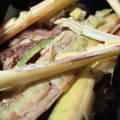100% Plants
Almost all garments produced today are colored with petrochemical dyes,
releasing toxic waste into our precious ecosystems everyday.
We believe Nature holds the solution to some of our most pressing environmental issues.
Through our continuous natural innovations, all our clothes are colored with plants.
Almost all garments produced today are colored with petrochemical dyes, releasing toxic waste into our precious ecosystems everyday.
We believe Nature holds the solution to some of our most pressing environmental issues. Through our continuous natural innovations, all our clothes are colored with plants.

What we wear shouldn't come at the cost of our planet.
Most garments today are colored with synthetic chemicals. Its wastewater, a cocktail of chemicals containing hard metals, are often thrown directly into the water ways.
When these toxic dyes are released into our environment, it keeps circulating between the soil, plants, animals and people. Causing health and environmental issues for the community.
But it doesn’t have to be this way. It's possible to create clothes in a way that doesn't cost the planet and directly benefits indigenous people.
This isn't fiction or fantasy. It's how we can change the lives of entire communities dependent on the preservation of their heritage and connection to the land.
What we wear shouldn't come
at the cost of our planet.
Most garments today are colored with synthetic chemicals. Its wastewater, a cocktail of chemicals containing hard metals, are often thrown directly into the water ways.
When these toxic dyes are released into our environment, it keeps circulating between the soil, plants, animals and people. Causing health and environmental issues for the community.
But it doesn’t have to be this way. It's possible to create clothes in a way that doesn't cost the planet and directly benefits indigenous people.
This isn't fiction or fantasy. It's how we can change the lives of entire communities dependent on the preservation of their heritage and connection to the land.
What is natural dyeing?
Natural dyeing with plants is one of the most sustainable dyeing methods out there. Less than 200 years ago, the whole world was wearing clothes that were botanically dyed.
That means that during our great grandparents' time, literally each color came from plants that grew in their surroundings.
A time-honored craft that was lost, for the sake of industrialization and fast fashion.
That's why we use only natural dyes to color your most meaningful clothes. Using plants that regenerate ecosystems, empower smallholder farmers, and reverse climate change.
Perfected over hundreds of hours of research. Learning and re-learning what it means to live in harmony with Nature. Not through a small capsule collection, but in all our clothes.
Replacing petroleum-based synthetic dyes with plants grown regeneratively, nurtured by the sun and the rain. They're beautiful, non-toxic, and better for your health - a win for all.
We make clothes the way Nature intends:
Slow, empowering,
and regenerative.
From farm to closet, we work with smallholder farmers
in rural Indonesia to sustain indigenous plants and dye traditions.
Our Plant Dyes & Natural Mordants
From Soil, For Soil™
Every SukkhaCitta piece is made by hand, taking over four months to craft from farm to closet. Each is a conversation; An invitation for you to reconnect with Nature and all the hands in between. Guided by intuition passed down over generations. Using only plants that protect rivers from toxic chemicals while restoring the health of our soil.
In a world where everyone wants to be fast, it takes courage to sit back and wait to make it perfect.
Every SukkhaCitta piece is made by hand, taking over four months to craft from farm to closet. Each is a conversation; An invitation for you to reconnect with Nature and all the hands in between.
Guided by intuition passed down over generations. Using only plants that protect rivers from toxic chemicals while restoring the health of our soil.
In a world where everyone wants to be fast, it takes courage to sit back and wait to make it perfect.








